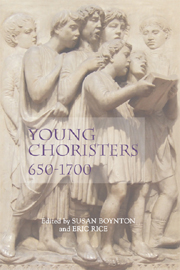Book contents
- Frontmatter
- Contents
- List of Illustrations
- List of Musical Examples
- Acknowledgements
- Dedication
- Introduction: Performance and Premodern Childhood
- 1 The Boy Singers of the Roman Schola Cantorum
- 2 Boy Singers in Medieval Monasteries and Cathedrals
- 3 The Musical Education of Young Girls in Medieval English Nunneries
- 4 Choirboys in Early English Religious Drama
- 5 From Mozos de coro towards Seises: Boys in the Musical Life of Seville Cathedral in the Fifteenth and Sixteenth Centuries
- 6 The Seeds of Medieval Music: Choirboys and Musical Training in a Late-Medieval Maîtrise
- 7 Choirboys in Cambrai in the Fifteenth Century
- 8 Choirboys and Vicaires at the Maîtrise of Cambrai: A Socio-anthropological Study (1550–1670)
- 9 Choirboys, Memorial Endowments and Education at Aachen's Marienkirche
- 10 Thomas Mulliner: An Apprentice of John Heywood?
- 11 Cantando tutte insieme: Training Girl Singers in Early Modern Sienese Convents
- 12 Choirboys in Early Modern Rome
- General Bibliography
- Index
9 - Choirboys, Memorial Endowments and Education at Aachen's Marienkirche
Published online by Cambridge University Press: 12 September 2012
- Frontmatter
- Contents
- List of Illustrations
- List of Musical Examples
- Acknowledgements
- Dedication
- Introduction: Performance and Premodern Childhood
- 1 The Boy Singers of the Roman Schola Cantorum
- 2 Boy Singers in Medieval Monasteries and Cathedrals
- 3 The Musical Education of Young Girls in Medieval English Nunneries
- 4 Choirboys in Early English Religious Drama
- 5 From Mozos de coro towards Seises: Boys in the Musical Life of Seville Cathedral in the Fifteenth and Sixteenth Centuries
- 6 The Seeds of Medieval Music: Choirboys and Musical Training in a Late-Medieval Maîtrise
- 7 Choirboys in Cambrai in the Fifteenth Century
- 8 Choirboys and Vicaires at the Maîtrise of Cambrai: A Socio-anthropological Study (1550–1670)
- 9 Choirboys, Memorial Endowments and Education at Aachen's Marienkirche
- 10 Thomas Mulliner: An Apprentice of John Heywood?
- 11 Cantando tutte insieme: Training Girl Singers in Early Modern Sienese Convents
- 12 Choirboys in Early Modern Rome
- General Bibliography
- Index
Summary
WHEN Charlemagne built what was to become the Collegiate Church of St. Mary in Aachen in about 800, he endowed the institution substantially. Since no document recording the initial endowment of the church or the establishment of its college of canons survives, however, the exact nature of the institution at the time of its founding has been the subject of debate. On one side, scholars such as Josef Fleckenstein believe that the church was a private chapel – essentially an itinerant court chapel that was installed in Aachen's Marienkirche. other scholars have been more cautious, expressing doubt that Charlemagne's chaplains would have lived according to a religious rule like that of Aachen's collegiate church and citing the difficulty of distinguishing between monks and canons in the religious culture of the eighth and ninth centuries. On the other side, scholars such as Ludwig Falkenstein believe that Aachen's Marienkirche was founded as a collegiate church, noting that the charter of Compiègne's collegiate church cites its Carolingian forerunner as a model. Though it may not be possible to determine the true nature of the Marienkirche at its founding, the distinction is important for my present subject: collegiate churches were more likely to have schools associated with them than were itinerant chapels, and though choirboys were usually present in both cases, provisions for their care and education were generally more substantial in collegiate churches.
- Type
- Chapter
- Information
- Young Choristers, 650–1700 , pp. 163 - 172Publisher: Boydell & BrewerPrint publication year: 2008



